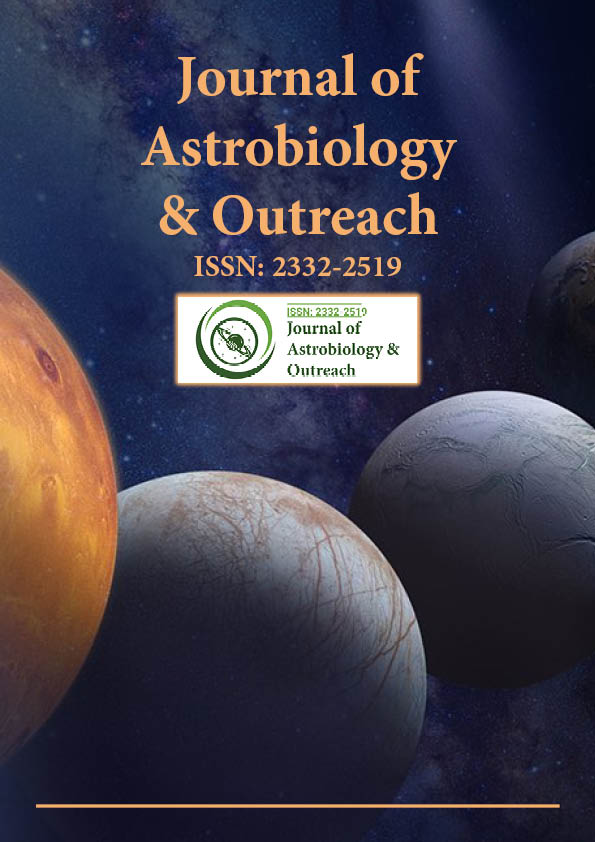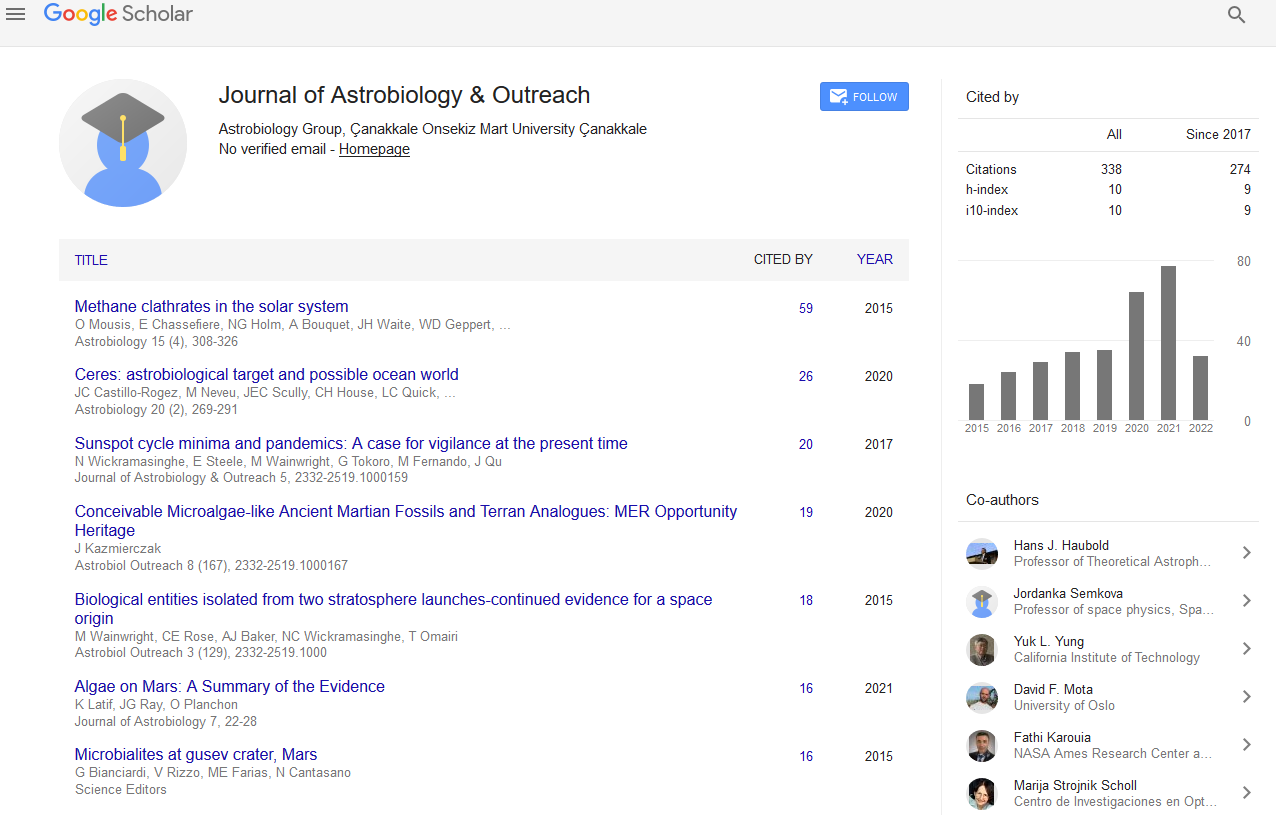Indexed In
- Open J Gate
- Academic Keys
- JournalTOCs
- RefSeek
- Hamdard University
- EBSCO A-Z
- OCLC- WorldCat
- Google Scholar
Useful Links
Share This Page
Journal Flyer

Open Access Journals
- Agri and Aquaculture
- Biochemistry
- Bioinformatics & Systems Biology
- Business & Management
- Chemistry
- Clinical Sciences
- Engineering
- Food & Nutrition
- General Science
- Genetics & Molecular Biology
- Immunology & Microbiology
- Medical Sciences
- Neuroscience & Psychology
- Nursing & Health Care
- Pharmaceutical Sciences
Short Communication - (2025) Volume 13, Issue 2
Astrobiology and the Origins of Life: From Signals to Significance
Stephen Munro*Received: 16-Dec-2023, Manuscript No. JAO-23-24456; Editor assigned: 19-Dec-2023, Pre QC No. JAO-23-24456 (PQ); Reviewed: 02-Jan-2024, QC No. JAO-23-24456; Revised: 13-Feb-2025, Manuscript No. JAO-23-24456 (R); Published: 20-Feb-2025, DOI: 10.35248/2332-2519.25.13.371
Description
Astrobiology, an interdisciplinary field that combines elements of biology, chemistry, physics, and astronomy, seeks to unravel the mysteries surrounding life beyond Earth and the cosmic processes that led to its emergence. Astrobiology's begins with the exploration of celestial bodies and the search for signals that may hint at the existence of extraterrestrial life. The discovery of exoplanets, planets orbiting stars beyond the solar system, has opened new avenues for investigation. The identification of habitable zones, regions where liquid water could exist, fuels the imagination with the possibility that life may thrive beyond the planetary borders.
Within the solar system, Mars has emerged as a focal point for astrobiological exploration. The red planet, with its barren landscapes and tantalizing hints of past water flows, has long intrigued scientists. Robotic missions, like NASA's perseverance rover, delve into Martian terrain, seeking evidence of microbial life or the building blocks that could support it. Such missions serve as a testament to humanity's commitment to unraveling the mysteries of the celestial neighbors.
Beyond the immediate cosmic neighborhood, radio signals from deep space have long captured the attention of scientists engaged in the Search for Extraterrestrial Intelligence (SETI). The famous Drake equation attempts to quantify the number of communicative civilizations in the galaxy, highlighting the multifaceted nature of the search for cosmic companions. While radio signals are but whispers in the vastness of space, their potential discovery would revolutionize the understanding of life's prevalence in the universe. The study of abiogenesis, the origin of life from non-living matter, delves into the fundamental chemistry that underlies the transition from simple organic molecules to complex, self-replicating entities. This exploration takes us back to the primordial Earth, where conditions were ripe for the formation of life.
Extremophiles and the limits of life
Astrobiology trials the preconceived notions of where life can increase. The possibility of planetary habitability has increased with the discovery of extremophiles, organisms that increase in different conditions previously thought to be uninhabitable. From the acidic pools of yellow stone to the icy depths of Antarctica, extremophiles demonstrate life's adaptability to a wide range of conditions. This adaptability prompts scientists to reconsider the possibilities for life beyond Earth, including the potential habitability of exoplanets with extreme climates.
Habitability beyond Earth
As astrobiologists explore the conditions necessary for life, the focus extends beyond Earth to other celestial bodies within the solar system and beyond. Mars, with its ancient riverbeds and subsurface water ice, has been a prime target for astrobiological exploration. Probes and rovers have been deployed to search for traces of past or present microbial life. The icy moons of Jupiter and Saturn, such as Europa and Enceladus, also capture scientific interest due to their subsurface oceans, raising the tantalizing possibility of extraterrestrial life thriving in these hidden watery realms.
Goldilocks zone and exoplanets
The concept of the habitable zone, often referred to as the goldilocks zone, is vital in astrobiology. This zone around a star represents the region where conditions are just right for liquid water to exist a key ingredient for life. As telescopes detect an increasing number of exoplanets in their star's habitable zones, astrobiologists contemplate the potential for life on these distant. The search for exoplanets with Earth-like characteristics, known as exoplanetary habitability, is a pivotal aspect of astrobiology's quest to identify potentially habitable environments beyond the solar system.
From signals to significance
The search for extraterrestrial signals persists, fueled by advancements in technology and the growing understanding of the cosmos. Simultaneously, the study of life's origins on Earth and the potential habitability of other celestial bodies enriches the understanding of the conditions necessary for life to rise and increase. One of the key milestones in understanding the origins of life on Earth is the Miller-Urey experiment, conducted in the 1950's. This groundbreaking experiment simulated the conditions of the early Earth, demonstrating that amino acids the building blocks of proteins could spontaneously form from simple chemical precursors. While the experiment did not create life itself, it provided a vital glimpse into the plausibility of life's emergence through natural processes.
Recent advancements in astrobiology include the study of extremophiles, organisms that thrive in extreme environments on Earth, such as deep-sea hydrothermal vents or acidic hot springs. These extremophiles offer valuable insights into the resilience of life and expand the range of potential habitable environments both on Earth and beyond. The discovery of microbial life in seemingly inhospitable places fuels optimism about the possibility of life existing in extreme conditions on other planets or moons. Astrobiology also explores the potential for life beyond traditional organic chemistry. The discovery of exoplanets with atmospheres containing bio signature gases molecules indicative of biological activity adds a layer of complexity to the search for extraterrestrial life. Researchers are developing models to distinguish between abiotic and biotic processes, aiming to identify the telltale signs of life in the atmospheres.
Conclusion
The quest to understand the origins of life prompts contemplation of the place in the cosmos and the connection to the universe. The realization that life's building blocks are scattered throughout the cosmos in the form of organic molecules, and that the conditions for life may exist on distant planets, fosters a profound sense of cosmic interconnectedness. Furthermore, astrobiology stimulates philosophical reflections on the nature of life and its potential manifestations. The discovery of extraterrestrial life, even in microbial form, would revolutionize the understanding of life as a cosmic phenomenon rather than a unique occurrence confined to Earth.
Astrobiology is a journey from deciphering cosmic signals to discovering the deep significance of life's beginnings. Whether exploring distant planets, deciphering radio signals, studying extremophiles on Earth, or contemplating the philosophical implications of life beyond the planet, astrobiology encompasses a vast and interconnected tapestry of scientific inquiry. As humanity continues its exploration of the cosmos, astrobiology stands at the forefront, offering a pathway to understanding the universal origins of life and the place in the grand tapestry of existence.
Citation: Munro S (2025) Astrobiology and the Origins of Life: From Signals to Significance. J Astrobiol Outreach. 13:371
Copyright: © 2025 Munro S. This is an open-access article distributed under the terms of the Creative Commons Attribution License, which permits unrestricted use, distribution, and reproduction in any medium, provided the original author and source are credited.

